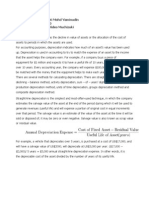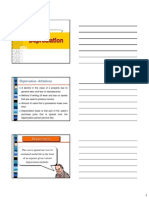DD&A
DD&A
Uploaded by
yosefmoneamCopyright:
Available Formats
DD&A
DD&A
Uploaded by
yosefmoneamCopyright
Available Formats
Share this document
Did you find this document useful?
Is this content inappropriate?
Copyright:
Available Formats
DD&A
DD&A
Uploaded by
yosefmoneamCopyright:
Available Formats
DD&A
What is DD&A?
DD&A stands for Depreciation, Depletion, and Amortization and represents an approach
in accounting that helps organizations gradually charge certain costs to expenses,
enabling a reduction in the value of an asset.
DD&A (Depreciation, depletion, and amortisation) is an accounting approach that assists
organisations in gradually spending certain assets from financial balance to equate
dividend expenses.
The decrease affects the value of an asset. As a result, deficiency is associated with the
value of withdrawing natural assets, whereas amortisation is affiliated with the correction
of untouchable assets.
These techniques are most likely used in the procurement, analysis, and evolution of the
most recent oil refineries and natural gas storage facilities.
The organization's net income statement includes allegations of depreciation, depletion,
and amortisation.
Also Reduction preserves the value of an existing resource beyond its useful life;
deficiency emphasises the importance of extracting natural assets such as minerals,
timber, and oil from the earth's core. Finally, amortisation refers to the removal of non-
touchable resources after a set period of time. Definitely, the total age of a resource. In
general, all industries are familiar with amortisation and depreciation, whereas depletion
is more specifically used by natural resource organisations. As a result, these techniques
are likely to be used in the procurement, analysis, and evolution of the most recent oil
refineries and natural gas storage facilities.
DD&A Awareness:
Accumulation accounts enable an organisation to admit central expenditures over time in
order to demonstrate the utilisation of linked resources. In short, this enables businesses
to compare the costs accumulated to achieve specific output.
For example, a machine or its component requires a significant amount of money to be
disbursed, which can be spent over the course of its working lifecycle rather than at a
specific time interval when the allocation occurred. As a result, such an accounting
approach is created in order to achieve more precise outcomes in terms of financial
return.
What is DD&A per BOE?
DDA&A per BOE stands for Depreciation, Depletion, and Amortization for Barrel of Oil
Equivalent and represents a cost reduction (value decrease) for the amount of energy
found in a barrel of crude oil.
What is Depreciation?
Depreciation is an accounting technique that allocates the expense of tangible assets as they lose
value as time passes until their value is zero. For example, if you purchase a machine for
$100,000 and its service life is 5 years, the machine's value will go down by $2000 per year until
it reaches zero. Reduction (depreciation) refers to the cost of purchasing a resource with a useful
life of more than a year. As a result, a percentage of its value is deducted from its approximated
performing life cycle.
What is Depletion?
Depletion denotes a drop in quantity as a physical decrease of the company's natural resources.
Depletion, for example, occurs when the supply of a particular natural resource, such as coil,
minerals, oil, forest, and so on, is depleted. Deficiency (depletion) reduces the cumulative cost of
resources through organised imputation to compensation. However, it differs in terms of the slow
deterioration of natural resources, as opposed to the wear and tear of reliable resources or the life
cycle of intangible resources. Prospectors, oil and gas drillers, loggers, and other firms involved
in natural resource withdrawals typically account for this expenditure. Companies that have
budgetary issues in ore assets or footing timber can consider insufficiency expenditures in
relation to the resources used. It can be calculated as a percentage of its value, and a company
should select the one that provides the greatest tax savings.
Depreciation vs. Depletion
The distinction between depreciation and depletion is that depreciation reflects a decrease in the
value of a tangible asset, whereas depletion represents a decrease in the value of an intangible
asset (for example machine value in dollars-decrease every year). Depletion, on the opposite
hand, is the physical decrease of resources (for example, 5 tonnes of forest depletion).
You might also like
- Accounting For DepreciationDocument16 pagesAccounting For DepreciationKrishna100% (4)
- Bulk Mro Industrial Supply Private Limited: Detailed ReportDocument10 pagesBulk Mro Industrial Supply Private Limited: Detailed ReportAnishNo ratings yet
- Erpnext TutorialDocument131 pagesErpnext TutorialPrapto Nugroho S100% (2)
- Depreciation - WikipediaDocument10 pagesDepreciation - Wikipediapuput075No ratings yet
- DepletionDocument3 pagesDepletioncheesequesoNo ratings yet
- Chapter 11 DepreciationDocument18 pagesChapter 11 Depreciationyagnesh211733No ratings yet
- NOTES UNIT-2 (1)Document32 pagesNOTES UNIT-2 (1)Piyush malikNo ratings yet
- Chapter 11 - Depreciation and DepletionDocument46 pagesChapter 11 - Depreciation and DepletionDawn Rei DangkiwNo ratings yet
- DepreciationDocument5 pagesDepreciationAniket Paul ChoudhuryNo ratings yet
- Lesson 14: DepreciationDocument36 pagesLesson 14: DepreciationMark Lacaste De GuzmanNo ratings yet
- notes of inventory valuation and DepreciationDocument8 pagesnotes of inventory valuation and DepreciationrezinsinghNo ratings yet
- Accountancy - DepreciationDocument4 pagesAccountancy - DepreciationGedie RocamoraNo ratings yet
- Chapter 2 PPEDocument16 pagesChapter 2 PPEcherunegashNo ratings yet
- MBA Chp-11 - DepreciationDocument30 pagesMBA Chp-11 - DepreciationNitish rajNo ratings yet
- DEPRECIATIONDocument38 pagesDEPRECIATIONJun TiNo ratings yet
- DepreciationDocument4 pagesDepreciationPRODYOT SINHANo ratings yet
- 3900 Topper 21 101 503 550 8491 Depreciation Provisions and Reserves Up201608051529 1470391159 3522 PDFDocument17 pages3900 Topper 21 101 503 550 8491 Depreciation Provisions and Reserves Up201608051529 1470391159 3522 PDFManju BalajiNo ratings yet
- DepreciationDocument10 pagesDepreciationsoumibasuNo ratings yet
- Definition of DepreciationDocument10 pagesDefinition of DepreciationSureshKumarNo ratings yet
- Unit - 5 DepreciationDocument19 pagesUnit - 5 DepreciationGeethaNo ratings yet
- Accounting (Depreciation)Document11 pagesAccounting (Depreciation)PowerPoint GoNo ratings yet
- Chapter 11 Study GuideDocument9 pagesChapter 11 Study GuideAngelia TNo ratings yet
- 3.2 Depreciation: Engineering EconomicsDocument11 pages3.2 Depreciation: Engineering Economicsrobel popNo ratings yet
- Unit 5 BBA SEM I DepreciationDocument24 pagesUnit 5 BBA SEM I DepreciationRaghuNo ratings yet
- Accounting For Non-Current AssetsDocument8 pagesAccounting For Non-Current Assetsarifunique5No ratings yet
- Theory of DepreciationDocument7 pagesTheory of DepreciationNaman TyagiNo ratings yet
- Depreciation, Provisions and ReservesDocument27 pagesDepreciation, Provisions and Reservesabhinandbabu314No ratings yet
- Student Notes Chap 11Document6 pagesStudent Notes Chap 11TINAIDANo ratings yet
- Depreciation 2023-2024 Iisjed Class For 12th Standard CBSEDocument29 pagesDepreciation 2023-2024 Iisjed Class For 12th Standard CBSETaLHa iNaM sameerNo ratings yet
- Accounting For DepreciationDocument31 pagesAccounting For DepreciationImran KhanNo ratings yet
- PPE, NR, IA NEW - StudentsDocument13 pagesPPE, NR, IA NEW - StudentsGedionNo ratings yet
- Depreciation and AmortizationDocument12 pagesDepreciation and Amortizationabdullahkhattak0076No ratings yet
- Depreciation: The Evolution of Accounting and Accounting TerminologyDocument11 pagesDepreciation: The Evolution of Accounting and Accounting TerminologyGlenNo ratings yet
- Depreciation Accounting & Methods: Dr. Pallavi IngaleDocument37 pagesDepreciation Accounting & Methods: Dr. Pallavi IngalePallavi IngaleNo ratings yet
- Investment Apraisal and DepriciationDocument10 pagesInvestment Apraisal and DepriciationShish DattaNo ratings yet
- Donald E Kieso, Weygandt, Warfield Intermediate Accounting IFRSDocument5 pagesDonald E Kieso, Weygandt, Warfield Intermediate Accounting IFRSshamseali98No ratings yet
- Finance TerminolgioesDocument4 pagesFinance Terminolgioesmallikarjun199No ratings yet
- Cost of ProdDocument4 pagesCost of ProdjhouvanNo ratings yet
- Intangible AssetsDocument10 pagesIntangible Assetssamuel debebeNo ratings yet
- Stafford CaseDocument31 pagesStafford CaseJennineNo ratings yet
- Depreciation: Salient FeaturesDocument12 pagesDepreciation: Salient FeaturesSudhir Kumar YadavNo ratings yet
- Chapter Three - Plant AssetDocument23 pagesChapter Three - Plant AssetGizaw BelayNo ratings yet
- Week 12 - Capex and DepreciationDocument55 pagesWeek 12 - Capex and DepreciationajenggNo ratings yet
- Depreciation: Depreciation Is A Term Used inDocument10 pagesDepreciation: Depreciation Is A Term Used inalbertNo ratings yet
- Topic 3-DeprDocument28 pagesTopic 3-DeprMichael.land65No ratings yet
- Depreciation HideODocument1 pageDepreciation HideOJasmin YaminudinNo ratings yet
- Engineering Economics - DepreciationDocument13 pagesEngineering Economics - DepreciationAbdulrahman HaidarNo ratings yet
- CHAPTER 8 - DepreciationDocument12 pagesCHAPTER 8 - DepreciationMuhammad AdibNo ratings yet
- 27ed6fa9-ed22-46d0-8794-53e3d26cc923Document59 pages27ed6fa9-ed22-46d0-8794-53e3d26cc923abhijitkumarsingh317No ratings yet
- Depletion: Valix, C. T. Et Al. Intermediate GIC Enterprises & Co. IncDocument21 pagesDepletion: Valix, C. T. Et Al. Intermediate GIC Enterprises & Co. IncJoris YapNo ratings yet
- Depriciation Capital Cost Allowance and Depreciation - Types of DepreciationDocument4 pagesDepriciation Capital Cost Allowance and Depreciation - Types of DepreciationSantosh KakadNo ratings yet
- DepriciationDocument4 pagesDepriciationnehagupta4915No ratings yet
- Accounting For The Environment (362-372)Document34 pagesAccounting For The Environment (362-372)Ritika VatyaniNo ratings yet
- FAM Presentation MODULE-3Document72 pagesFAM Presentation MODULE-3upperdig5No ratings yet
- Content On Pp&e-2Document16 pagesContent On Pp&e-2augustinepukah9No ratings yet
- Guru Ghasidas Vishwavidyalaya: BILASPUR (C.G.) 495009Document25 pagesGuru Ghasidas Vishwavidyalaya: BILASPUR (C.G.) 495009Ashay kanchanNo ratings yet
- 2022 11ambition Gap ReportDocument15 pages2022 11ambition Gap ReportmavarinNo ratings yet
- Unit 5Document22 pagesUnit 5sumitbabu0210No ratings yet
- Depreciation TheoryDocument17 pagesDepreciation Theoryvarun rajNo ratings yet
- Depriciation AccountingDocument42 pagesDepriciation Accountingezek1elNo ratings yet
- Depreciation Notes - Advanced AccountingDocument16 pagesDepreciation Notes - Advanced AccountingSam ChinthaNo ratings yet
- The Entrepreneur’S Dictionary of Business and Financial TermsFrom EverandThe Entrepreneur’S Dictionary of Business and Financial TermsNo ratings yet
- CLC Executive Summary Driving Performance and Retention Through Employee EngagementDocument24 pagesCLC Executive Summary Driving Performance and Retention Through Employee Engagementg111reggNo ratings yet
- Inter Mid IateDocument171 pagesInter Mid IateSHIVINo ratings yet
- Student Satisfaction Survey Literature ReviewDocument8 pagesStudent Satisfaction Survey Literature Reviewcjxfjjvkg100% (1)
- Lesson 6 Persuasion and Negotiating SkillsDocument3 pagesLesson 6 Persuasion and Negotiating SkillsMelvinNo ratings yet
- School of Economics: Quaid-i-Azam University, IslamabadDocument59 pagesSchool of Economics: Quaid-i-Azam University, IslamabadArsalan AhmedNo ratings yet
- Annual Report 2020 PDFDocument388 pagesAnnual Report 2020 PDFvisutsiNo ratings yet
- PADARIADocument2 pagesPADARIAMussa Alberto Malfazer MalfazerNo ratings yet
- Group 1 ProposalDocument24 pagesGroup 1 ProposalBiruk100% (1)
- EP0503 - 4. Fleet PlanningDocument19 pagesEP0503 - 4. Fleet PlanningJackLiewNo ratings yet
- Effects in Economic Decisions: Consumer EducationDocument53 pagesEffects in Economic Decisions: Consumer EducationJing KhaiNo ratings yet
- Deloitte 2024 Cxo Sustainability ReportDocument26 pagesDeloitte 2024 Cxo Sustainability ReportSustenomicsNo ratings yet
- Steps To Prepare CompostDocument2 pagesSteps To Prepare CompostRonalit MalintadNo ratings yet
- Jafer Sadique - ISSN - 0731-6755Document17 pagesJafer Sadique - ISSN - 0731-6755Jaffar SadiqNo ratings yet
- Entrepreneurship: Chapter 3: Generating and Exploiting New Entries Course InstructorDocument29 pagesEntrepreneurship: Chapter 3: Generating and Exploiting New Entries Course InstructorZarnain khanNo ratings yet
- Money Management CycleDocument25 pagesMoney Management CycleabieNo ratings yet
- Turn Your Instagram Into A: 6-Figure Side HustleDocument19 pagesTurn Your Instagram Into A: 6-Figure Side HustleHow to Buddy100% (3)
- Disaster Recovery Plan SparqDocument7 pagesDisaster Recovery Plan Sparqfawas hamdiNo ratings yet
- Questionnaire Financial Literacy in EMS WIL 1 TASK LatestDocument1 pageQuestionnaire Financial Literacy in EMS WIL 1 TASK Latestrichard tabaneNo ratings yet
- Case Analysis Land LawDocument4 pagesCase Analysis Land LawAayushi PriyaNo ratings yet
- BLIP - Talent Acquisition Trainee Challenge (TOPIC 3)Document7 pagesBLIP - Talent Acquisition Trainee Challenge (TOPIC 3)PatrpbNo ratings yet
- LSSBB Study MaterialDocument326 pagesLSSBB Study MaterialOMER SOHAIBNo ratings yet
- Materials Management: DefinitionDocument3 pagesMaterials Management: DefinitionvijiNo ratings yet
- Mdpe Pipes and FittingDocument2 pagesMdpe Pipes and FittingNitesh SrivastavaNo ratings yet
- BSL 101 Assignment 2Document7 pagesBSL 101 Assignment 2parivesh GoyalNo ratings yet
- The Recovery of Debts Due To Banks and Financial Institutions ACT, 1993Document21 pagesThe Recovery of Debts Due To Banks and Financial Institutions ACT, 1993jagankilariNo ratings yet
- Module 7 - Interaction of Deamnd and SupplyDocument20 pagesModule 7 - Interaction of Deamnd and SupplyllanahbayugaoNo ratings yet
- Asian Paints Investor Presentation Q4 FY24Document25 pagesAsian Paints Investor Presentation Q4 FY24Sibin MathewsNo ratings yet
- Resume - Alex LeeDocument1 pageResume - Alex Leeapi-679397913100% (1)

























































































